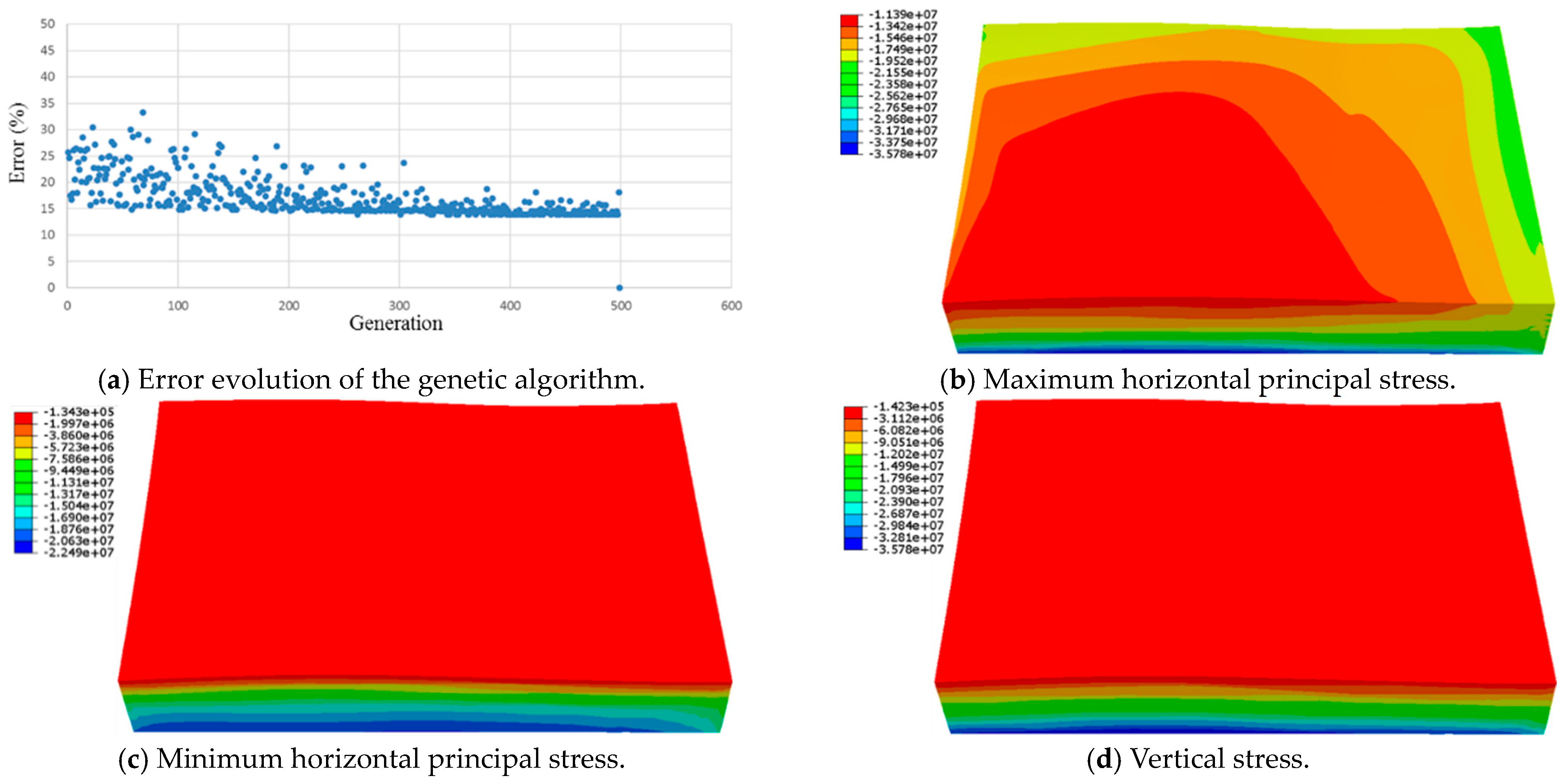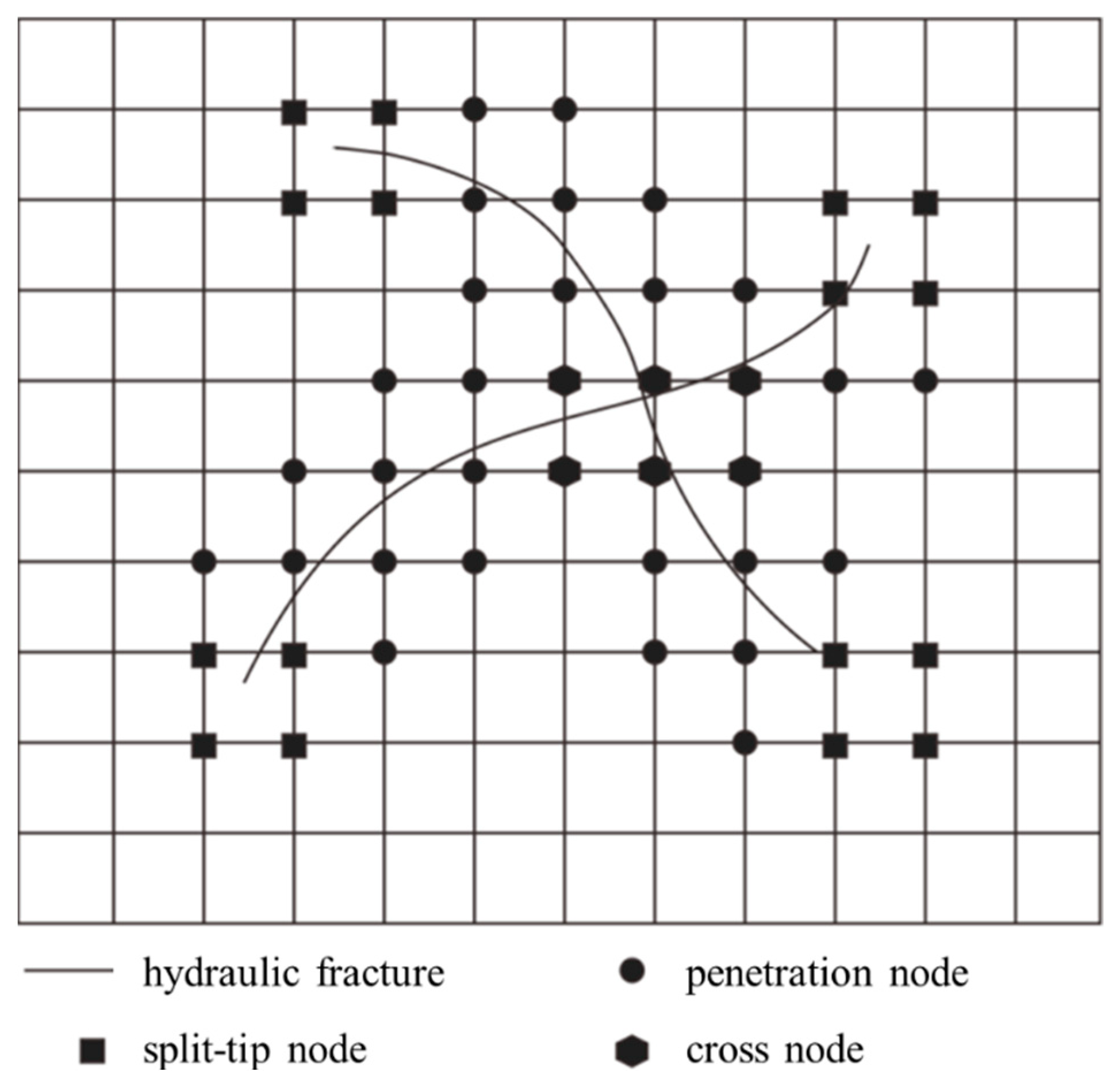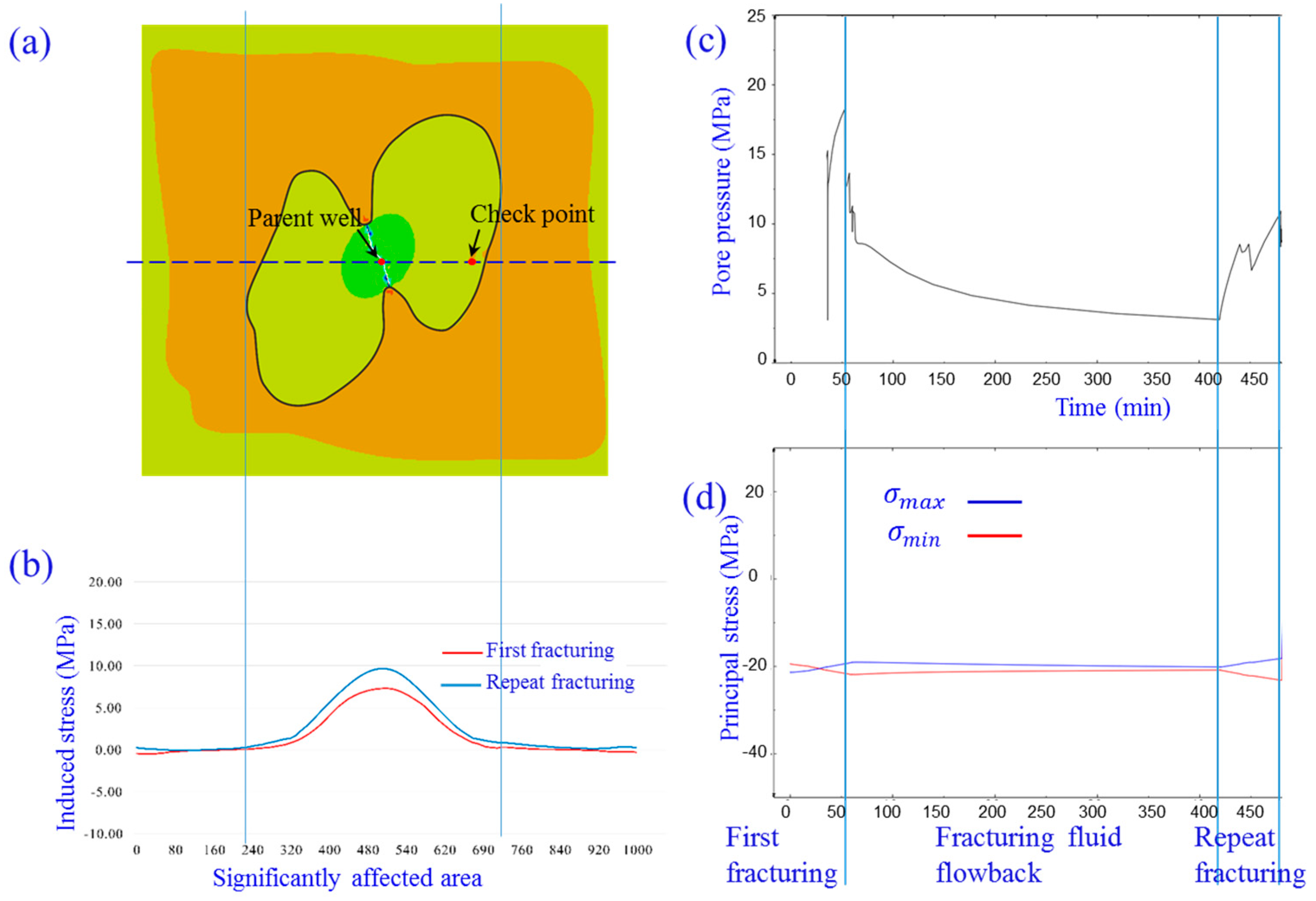Use of Extended Finite Element Method to Characterize Stress Interference Caused by Nonuniform Stress Distribution during Hydraulic Fracturing
Abstract
1. Introduction
2. Methods
2.1. Rock Mechanical Tests
2.2. Determining Rock Parameters with Logging Data
2.3. Estimation of the Pore Pressure
2.4. Estimation of the Principal Stresses
2.5. Three-Dimensional Geostress Field
3. Hydraulic Fracture Modelling
3.1. Modelling Approach
3.2. Hydraulic Fracture Modelling at the Parent Well
- Stage 1: The first fracturing occurred at 50 min; the flow ratio of the fracturing fluid was 2 m3/min.
- Stage 2: Fracturing fluid flowback occurred for 360 min.
- Stage 3: Fracturing repeated for 50 min; the flow ratio of the fracturing fluid was 2 m3/min.
3.2.1. First Fracturing Modelling
3.2.2. Fracturing Fluid Flowback and Repeat Fracturing
3.3. Modelling Result Discussion
3.4. Fracturing of the Child Well
4. Conclusions
- (1)
- Due to the induced tensile stress at the fracture tips and the induced compressive stress in the normal direction of the fracture length, the area affected by fracturing-induced stress formed a “butterfly type” area. In the E–W direction, the affected range after the first fracturing process at the parent well was 1.5–2 times the fracture length.
- (2)
- The fracturing fluid flowback at the parent well changed the magnitude of the maximum and minimum horizontal principal stresses, but their directions were not affected. After repeated fracturing at the parent well, the magnitude of the fracturing-induced stress increased, but its influence range did not increase significantly.
- (3)
- For a child well located within the “butterfly type” zone, the stress interference results in an asymmetric fracture propagation; meanwhile, for a child well located outside of this zone, a symmetric fracture geometry occurs.
- (4)
- The non-concurrent parent well and child well completions are the main cause of stress interference, and the effect of stress interference on the asymmetry of the child well fracture wings was negatively correlated with the distance between the parent well and the child well.
- (5)
- The fracture geometry under different well spacings was analyzed; this provided a method of optimizing the well space during parent well fracturing. In the simulations, the formation properties were assumed to be uniform. This was necessary for investigating the impact of nonuniform stress distribution on fracture propagation.
Author Contributions
Funding
Data Availability Statement
Conflicts of Interest
References
- Bowers, G.L. Pore pressure estimation from velocity data: Accounting for overpressure mechanisms besides undercompaction. SPE Drill. Complet. 1995, 10, 89–95. [Google Scholar] [CrossRef]
- Cheng, Y. Impacts of the number of perforation clusters and cluster spacing on production performance of horizontal shale-gas wells. SPE Reserv. Eval. Eng. 2012, 15, 31–40. [Google Scholar] [CrossRef]
- Esquivel, R.; Blasingame, T.A. Optimizing the Development of the Haynesville Shale-Lessons-Learned from Well-to-Well Hydraulic Fracture Interference. In Proceedings of the Unconventional Resources Technology Conference, Austin, TX, USA, 24–26 July 2017; Society of Exploration Geophysicists, American Association of Petroleum: Houston, TX, USA, 2017; pp. 1005–1026. [Google Scholar]
- Gala, D.P.; Manchanda, R.; Sharma, M.M. Modeling of fluid injection in depleted parent wells to minimize damage due to frac-hits. In Proceedings of the Unconventional Resources Technology Conference, Houston, TX, USA, 23–25 July 2018; Society of Exploration Geophysicists, American Association of Petroleum: Houston, TX, USA, 2018; pp. 4118–4131. [Google Scholar]
- Guo, X.; Ma, J.; Wang, S.; Zhu, T.; Jin, Y. Modeling Interwell Interference: A Study of the Effects of Parent Well Depletion on Asymmetric Fracture Propagation in Child Wells. In Proceedings of the SPE/IATMI Asia Pacific Oil & Gas Conference and Exhibition, Bali, Indonesia, 29–31 October 2019. [Google Scholar]
- Hu, X.; Liu, G.; Luo, G.; Ehlig-Economides, C. Model for Asymmetric Hydraulic Fractures with Nonuniform-Stress Distribution. SPE Prod. Oper. 2019, 36, 1–11. [Google Scholar] [CrossRef]
- Lawal, H.; Jackson, G.; Abolo, N.; Flores, C. A novel approach to modeling and forecasting frac hits in shale gas wells. In Proceedings of the EAGE Annual Conference & Exhibition Incorporating SPE Europec, London, UK, 10–13 June 2013; Society of Petroleum Engineers: Richardson, TX, USA, 2013. [Google Scholar]
- Lindsay, G.; Miller, G.; Xu, T.; Shan, D.; Baihly, J. Production performance of infill horizontal wells vs. pre-existing wells in the major US unconventional basins. In Proceedings of the SPE Hydraulic Fracturing Technology Conference and Exhibition, The Woodlands, TX, USA, 23–25 January 2018; Society of Petroleum Engineers: Richardson, TX, USA, 2018. [Google Scholar]
- Miller, G.; Lindsay, G.; Baihly, J.; Xu, T. Parent well refracturing: Economic safety nets in an uneconomic market. In Proceedings of the SPE Low Perm Symposium, Denver, CO, USA, 5–6 May 2016; Society of Petroleum Engineers: Richardson, TX, USA, 2016. [Google Scholar]
- Moës, N.; Belytschko, T. Extended finite element method for cohesive crack growth. Eng. Fract. Mech. 2002, 69, 813–833. [Google Scholar] [CrossRef]
- Montgomery, C.T.; Smith, M.B. Hydraulic fracturing: History of an enduring technology. J. Pet. Technol. 2010, 62, 26–40. [Google Scholar] [CrossRef]
- Olson, J.E. Predicting fracture swarms-The influence of subcritical crack growth and the crack-tip process zone on joint spacing in rock. Geol. Soc. Lond. Spec. Publ. 2004, 231, 73–88. [Google Scholar] [CrossRef]
- Rezaei, A.; Rafiee, M.; Bornia, G.; Soliman, M.; Morse, S. Protection Refrac: Analysis of pore pressure and stress change due to refracturing of Legacy Wells. In Proceedings of the Unconventional Resources Technology Conference, Austin, TX, USA, 24–26 July 2017; Society of Exploration Geophysicists, American Association of Petroleum: Houston, TX, USA, 2017; pp. 312–327. [Google Scholar]
- Salmachi, A.; Sayyafzadeh, M.; Haghighi, M. Infill well placement optimization in coal bed methane reservoirs using genetic algorithm. Fuel 2013, 111, 248–258. [Google Scholar] [CrossRef]
- Soliman, M.Y.; East, L.; Adams, D. Geomechanics aspects of multiple fracturing of horizontal and vertical wells. In Proceedings of the SPE International Thermal Operations and Heavy Oil Symposium and Western Regional Meeting, Bakersfield, CA, USA, 16–18 March 2004; Society of Petroleum Engineers: Richardson, TX, USA, 2004. [Google Scholar]
- Stephenson, B.; Galan, E.; Williams, W.; MacDonald, J.; Azad, A.; Carduner, R.; Zimmer, U. Geometry and failure mechanisms from microseismic in the Duvernay Shale to explain changes in well performance with drilling azimuth. In Proceedings of the SPE Hydraulic Fracturing Technology Conference and Exhibition, The Woodlands, TX, USA, 23–25 January 2018; Society of Petroleum Engineers: Richardson, TX, USA, 2018. [Google Scholar]
- Surendran, M.; Natarajan, S.; Palani, G.; Bordas, S.P. Linear smoothed extended finite element method for fatigue crack growth simulations. Eng. Fract. Mech. 2019, 206, 551–564. [Google Scholar] [CrossRef]
- Tang, H.; Wang, S.; Zhang, R.; Li, S.; Zhang, L.; Wu, Y.-S. Analysis of stress interference among multiple hydraulic fractures using a fully three-dimensional displacement discontinuity method. J. Pet. Sci. Eng. 2019, 179, 378–393. [Google Scholar] [CrossRef]
- Tang, H.; Winterfeld, P.H.; Wu, Y.-S.; Huang, Z.-Q.; Di, Y.; Pan, Z.; Zhang, J. Integrated simulation of multi-stage hydraulic fracturing in unconventional reservoirs. J. Nat. Gas Sci. 2016, 36, 875–892. [Google Scholar] [CrossRef]
- Walser, D.; Siddiqui, S. Quantifying and mitigating the impact of asymmetric induced hydraulic fracturing from horizontal development wellbores. In Proceedings of the SPE Annual Technical Conference and Exhibition, Dubai, United Arab Emirates, 26–28 September 2016; Society of Petroleum Engineers: Richardson, TX, USA, 2016. [Google Scholar]
- Wu, K.; Olson, J.; Balhoff, M.T.; Yu, W. Numerical analysis for promoting uniform development of simultaneous multiple-fracture propagation in horizontal wells. SPE Prod. Oper. 2017, 32, 41–50. [Google Scholar] [CrossRef]
- Yaich, E.; Diaz De Souza, O.C.; Foster, R.A.; Abou-Sayed, I.S. A Methodology to Quantify the Impact of Well Interference and Optimize Well Spacing in the Marcellus Shale. In Proceedings of the Spe/csur Unconventional Resources Conference—Canada, Calgary, AB, Canada, 30 September–2 October 2014. [Google Scholar]
- Zheng, H.; Pu, C.; Xu, E.; Sun, C. Numerical investigation on the effect of well interference on hydraulic fracture propagation in shale formation. Eng. Fract. Mech. 2020, 228, 106932. [Google Scholar] [CrossRef]











| Sample ID | Depth (m) | Density (g/cm3) | Porosity (%) | Confining Pressure (MPa) | Compressive Strength (MPa) | Poisson’s Ratio (1) | Es (MPa) |
|---|---|---|---|---|---|---|---|
| 1-1 | 645.35 | 2.59 | 1.5 | 0.0 | 62.544 | 0.306 | 54,760 |
| 1-2 | 645.38 | 2.60 | 1.1 | 0.0 | 53.202 | 0.057 | 10,544 |
| 1-3 | 645.67 | 2.63 | 1.2 | 3.0 | 92.200 | 0.266 | 47,382 |
| 1-4 | 645.72 | 2.61 | 1.8 | 6.0 | 118.385 | 0.218 | 40,955 |
| 1-5 | 645.87 | 2.64 | 1.4 | 3.0 | 89.452 | 0.215 | 37,995 |
| 1-6 | 645.83 | 2.64 | 1.8 | 9.0 | 107.814 | 0.241 | 37,939 |
| 1-7 | 646.02 | 2.63 | 1.1 | 6.0 | 108.887 | 0.217 | 38,042 |
| 1-10 | 646.54 | 2.62 | 1.3 | 9.0 | 81.300 | 0.195 | 28,079 |
| Item | Parameters | Unit | Value |
|---|---|---|---|
| Rock Mechanical properties | Young’s Modulus | GPa | 27.6 |
| Poisson’s Rate | Dimensionless | 0.34 | |
| Tensile strength | MPa | 8.42 | |
| Shear strength | MPa | 8.61 | |
| Permeability | mD | 0.35 | |
| Injection Parameters | Injection rate | m3/min | 2.0 |
| Viscosity of fracturing fluid | mPa.s | 20.0 | |
| Stress Field | Vertical stress | MPa | 15.0 |
| Maximum horizontal principal stress | MPa | 13.6 | |
| Minimum horizontal principal stress | MPa | 11.7 |
Disclaimer/Publisher’s Note: The statements, opinions and data contained in all publications are solely those of the individual author(s) and contributor(s) and not of MDPI and/or the editor(s). MDPI and/or the editor(s) disclaim responsibility for any injury to people or property resulting from any ideas, methods, instructions or products referred to in the content. |
© 2024 by the authors. Licensee MDPI, Basel, Switzerland. This article is an open access article distributed under the terms and conditions of the Creative Commons Attribution (CC BY) license (https://creativecommons.org/licenses/by/4.0/).
Share and Cite
Zhu, Y.; Wang, P.; Liao, Y.; Liao, R.; Zheng, H. Use of Extended Finite Element Method to Characterize Stress Interference Caused by Nonuniform Stress Distribution during Hydraulic Fracturing. Processes 2024, 12, 2089. https://doi.org/10.3390/pr12102089
Zhu Y, Wang P, Liao Y, Liao R, Zheng H. Use of Extended Finite Element Method to Characterize Stress Interference Caused by Nonuniform Stress Distribution during Hydraulic Fracturing. Processes. 2024; 12(10):2089. https://doi.org/10.3390/pr12102089
Chicago/Turabian StyleZhu, Yinghui, Pengxiang Wang, Yi Liao, Ruiquan Liao, and Heng Zheng. 2024. "Use of Extended Finite Element Method to Characterize Stress Interference Caused by Nonuniform Stress Distribution during Hydraulic Fracturing" Processes 12, no. 10: 2089. https://doi.org/10.3390/pr12102089
APA StyleZhu, Y., Wang, P., Liao, Y., Liao, R., & Zheng, H. (2024). Use of Extended Finite Element Method to Characterize Stress Interference Caused by Nonuniform Stress Distribution during Hydraulic Fracturing. Processes, 12(10), 2089. https://doi.org/10.3390/pr12102089






